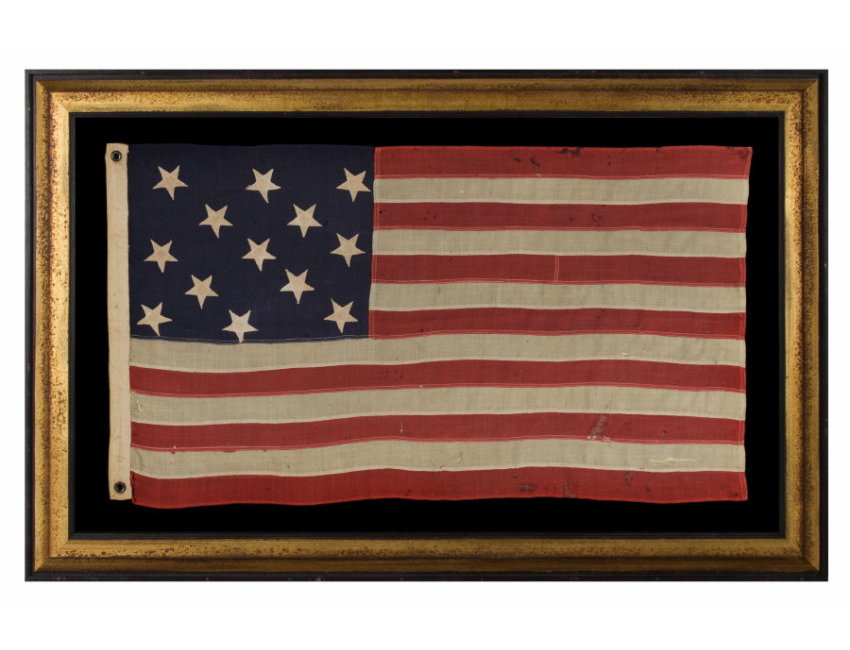|

|
Description: |
|
| 13 star flag of the type made from roughly the last decade of the 19th century through the first quarter of the 20th century. The stars are arranged in rows of 3-2-3-2-3, which is the most often seen pattern in 13 star flags of the late 19th and early 20th centuries. In most cases the 3-2-3-2-3 design can also be viewed as a diamond of stars, with a star in each corner and a star in the very center. The 3-2-3-2-3 pattern can also be interpreted as a combination of the crosses of St. Andrew and St. George, which some experts feel could have been the design of the very first American flag, serving as a link between this star pattern and the British Union Jack.
Note how the stars are upside-down in their vertical alignment (with two points up instead of one). No one knows if this positioning had any purpose, but there was no official way to orient the stars and it is possible that the maker of this flag did not feel that any star position was �right-side-up�. Whatever the case may be, the feature does add a degree of interest to the design.
Why 13 Stars? The U.S. Navy had long been using 13 stars on its small-scale flags because they wished the stars to be easily discerned at a distance. This was the original number of stars on the American flag and equal to the number of original colonies. As the number of stars grew with the addition of new states, two circumstances occurred. One, it became more and more difficult to fit stars on a small flag and two, it became increasingly difficult to discern them from afar as individual objects.
For all practical purposes, commercial flag-makers simply didn't produce flags with pieced-and-sewn construction that were 3 to 4 feet in length before the 1890's. The small size of these flags is significant, because with exception of military flank markers and camp colors, these were far smaller than almost any other type of Stars & Stripes flag sewn construction that was being produced during this era (and prior). There are exceptions to this rule, but until this time, the smallest sewn flags were approximately 6 feet on the fly. The primary use had long been more utilitarian than decorative, and flags needed to be large to be effective as signals. Private use grew with the passage of time and this led to the need for long-term use flags of more manageable scale.
Beginning around 1890, flag-makers began to produce small flags for the first time in large quantities. 2 x 3 feet and 2.5 x 4 feet were the most common sizes. This one is a slight variant at approximately 2 by just under 4 feet. Evidently applying the same logic as the U.S. Navy, they chose the 13 star count rather than the full complement of stars for sake of ease and visibility. Any American national flag that has previously been official remains so today, according to the flag acts. So the use of 13 stars, the official count from 1777 to 1795, was perfectly acceptable.
13 star flags have been used throughout our Nation's history for a variety of purposes. In addition to their use on the small scale flags of the 1890-1920's era, the U.S. Navy used the 13 star count on small boats, both in the 18th century and through most or all of the 19th century, particularly the second half. The Navy�s use of the 13 star flag ended in 1916 following an executive order written by President Woodrow Wilson. Among other uses, 13 star flags were carried by soldiers during the Mexican and Civil Wars, used at patriotic events, including Lafayette�s visit in 1825-26, celebration of the Nation�s centennial in 1876 and the sesquicentennial in 1926.
Construction: The canton and stripes of the flag are made of wool bunting, pieced with a treadle machine. The cotton stars are machine-sewn with a zigzag stitch and double-appliqu�d (applied to both sides of the flag). The zigzag stitch was first patented for use on flags in 1892, but it didn�t see widespread use until around 1896. There is a sailcloth canvas binding with 2 brass grommets for hoisting.
Mounting: The flag has been stitched to 100% silk organza on every seam and throughout the star field for support. Then flag was then hand-sewn to background of 100% cotton twill, black in color, which was washed to reduce excess dye. An acid-free agent was added to the wash to further set the dye and the fabric was heat-treated for the same purpose. The flag was then placed in a black-painted and hand-gilded, contemporary Italian molding. The glazing is U.V. protective acrylic. |
| Inventory Number: |
|
|
|
Dealer |
Jeff R. Bridgman American Antiques, llc |
| Contact |
Jeff Bridgman |
Phone: (717) 502-1281 |
|
| Period: |
19th Century (1801-1900) |
|
| Date: |
1895-1910 |
|
| Origin: |
|
|
| Condition: |
There is minor, scattered mothing throughout, but there are no serious condition issues. |
|
| Measurements: |
Frame: 35.75" x 55.75" Flag: 25.25" x 45.25" |
|
| Inventory |
Other Inventory by this Dealer |
|
| Web-site: |
http://www.jeffbridgman.com |
|
| Price: |
SOLD |
|
| E-mail: |
Inquire
|
|
Click thumbnail
to view larger
|
